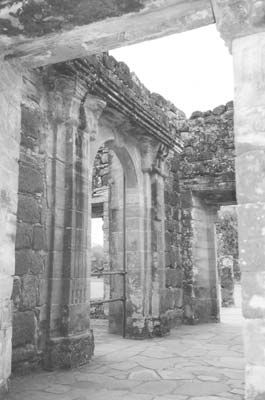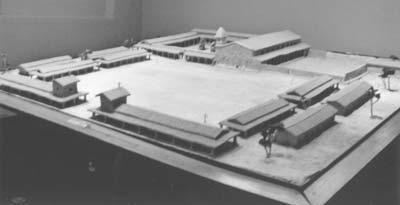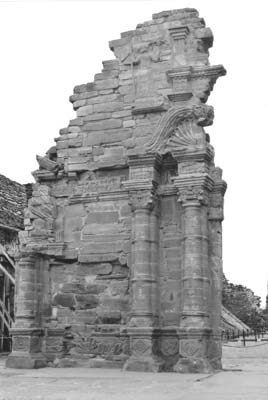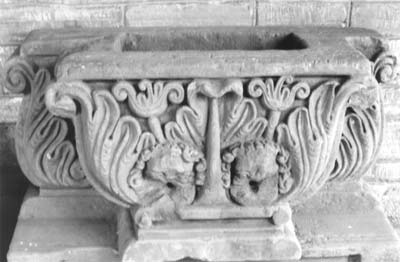Guaraní-Jesuit missions of Argentina
This item appears on page 82 of the May 2008 issue.
by Julie Skurdenis
The conquistadores arrived in South America early in the 16th century. They came hungry for land and hungry for gold. With them came priests and monks intent on spreading the Catholic faith among the many Indian groups.
One of the religious groups was the Jesuits, founded in 1540 by a Spaniard, Ignatius of Loyola. The Jesuits were a very structured and disciplined multinational order concerned not only with their own spiritual growth but with active proselytizing.
They carried their organizational skills and their desire to make conversions to the New World and, in the course of 158 years, worked to create a utopia among the Guaraní Indians of the Rio de la Plata area of southern South America.
The Jesuits arrived in Paraguay from Brazil in 1578. In 1607 they created the Jesuit “province” of Paraguay, based in Asunción, covering the vast area of Argentina, Paraguay, Uruguay, Chile, Bolivia and parts of Brazil. Here they set about building missions, called reducciones, the first of which, San Ignacio Guazú, was constructed in 1609.
Growth of the missions
Over the next century and a half, 30 missions were built — 15 in Argentina, eight in Paraguay and seven in Brazil. At their height, at the beginning of the 18th century, there were an estimated 140,000 Guaraní Indians living in the missions, an average of about 4,700 in each of the 30 missions.
The Jesuits offered the Guaranís protection from marauding bands of bandeirantes, the slave hunters who periodically raided Guaraní settlements taking captives.
The Jesuits also taught the Indians valuable skills — carpentry, masonry, woodworking, blacksmithing and sculpting — that were put to use building the missions. In addition, fields were planted, orchards cultivated and cattle bred and raised. Each mission, though in contact with other Guaraní-Jesuit missions, strove to be as completely self-sufficient as possible.
This all ended in 1767 when King Carlos III of Spain expelled the Jesuits from all territories of the Spanish empire. The reason was partially envy. The Spaniards in colonial South America resented the organizational skills that had created missions that were, in most cases, superior to colonial towns.
But there was also fear of growing Jesuit power. After 1767, some missions were given to other religious orders and some were sold or auctioned off, while others fell into ruin or were deliberately destroyed.
What remains, however, is impressive. My husband, Paul, and I visited three missions in ARGENTINA located close to each other about 150 miles southwest of Iguaçu Falls, one of the world’s greatest natural wonders, straddling the border between Argentina and Brazil.
Mission layout
Each mission followed a similar layout. A large central plaza was surrounded on three sides by numerous long rectangular stone houses, each house divided into units to house individual families. On the fourth side stood a large stone church with a school and workshops on one side and a cemetery and a cotiguazú, a house for widows and orphans, on the other.
Close to the church was a residence for the Jesuit priests — usually only two or three — who ministered to the needs of the mission.
Beyond the church and its surrounding buildings were vegetable gardens and, beyond these, fields planted with crops like cotton, maize, sugar, sweet potato, tobacco and, most important of all, yerba mate, whose leaves could be dried to be used as tea.
This layout varied among the missions but not much.
San Ignacio Mini
The first Argentinian mission we visited was San Ignacio Mini, a good choice, we felt, since it is the most complete of the three missions, making it easy to visualize its original layout.
Built in 1610, San Ignacio Mini was moved several times because of bandeirantes’ attacks until its final relocation in 1696 near the Argentinian town of Posadas. San Ignacio Mini is a 2½-hour drive southwest of Iguaçu Falls.
From the entrance, an avenue runs past stone houses that were Guaraní homes 300 years ago. Stone columns, remnants of an arcade, stand a few feet in front of these buildings. They once provided protection from the weather and perhaps space for women to set up their looms or do household chores outdoors.
At the end of this avenue was a large plaza with the mission church at its southern end. This church must have been spectacular because, though now in ruins, it is still impressive. It is immense — 243 feet by 79 feet — with three aisles divided by a double row of stone columns.
The carvings remaining on the church doorways and walls and the freestanding sculptures are magnificent. Carved in what has been called “Guaraní Baroque” or “Hispanic Baroque” style, the decoration features flowers, plants and birds native to this part of South America. There are also angels, some of which combine sinuous serpentine bodies with wings, making them look mildly sinister.
To the left of this church was a patio surrounded by schoolrooms, with a wide paved terrace and a beautiful stone balustrade in front. Next to this was another patio surrounded by workshops. To the right of the church was the cemetery and at one corner, the hospital, convenient but not exactly inspiring optimism among the sick.
Santa Ana
Santa Ana Mission is only a 20-minute drive from San Ignacio Mini. It was originally founded in 1633 but moved several times.
Santa Ana is in a much more ruinous state than San Ignacio Mini, although it is still possible to trace the outlines of the principal buildings: the church, colegio, or school, workshops and the many Guaraní houses that once sheltered a population of close to 4,400. Many stone walls remain although propped up by wooden supports to keep them from toppling.
What is especially moving about Santa Ana is its cemetery with many relatively recent burials. Even though Santa Ana, along with the other Guaraní-Jesuit missions, was drastically affected by the expulsion of the Jesuits in 1767 and most Guaraní living there left, some of their descendants are still buried next to the old church where their ancestors once worshiped.
Loreto
Nuestra Señora de Loreto Mission is another short 20-minute drive away from Santa Ana. Loreto, like San Ignacio Mini and Santa Ana, had a founding (1610) and several refoundings (1631 and 1686).
It is fortunate that we visited San Ignacio Mini first because if we hadn’t it would have been difficult, if not impossible, to decipher the layout of Loreto from what is left. It is almost totally in ruins, with much covered by tall trees and grass.
It’s very romantic to clamber up moss-covered steps and over stone walls with protruding tree roots, but it’s hard to distinguish what a particular building might have been unless you’ve been to San Ignacio Mini or studied the scale model of Loreto at the entrance to this mission.
Seven remaining Guaraní-Jesuit missions in Argentina, Paraguay and Brazil have been designated UNESCO World Heritage Sites. The three we visited are all on the list.
If you go. . .
• We visited the three missions in Argentina on a day trip from Iguaçu Falls, where we spent three nights on our 5-week-long trip to Buenos Aires in August 2007. The flight from Buenos Aires to Iguaçu Falls took about 90 minutes.
Our hotel was the Sheraton Iguaçu Resort, the place to stay on the Argentinian side of the falls. Our room had a long-distance view of the most spectacular of the falls, la Garganta del Diablo (Devil’s Throat). Best of all, we could do the three major walks to the falls — Lower Circuit, Upper Circuit and Devil’s Throat — from the hotel.
Room rates vary but during our visit started at about $300, including buffet breakfast. Reserve through Starwood Hotels (800/325-3535, www.starwoodhotels.com).
The Sheraton tour desk arranged the car and driver for our visit to the three missions. You really don’t need a guide because of the excellent plans and/or models at each site. The Sheraton gift shop sells a good booklet about the missions.
The cost of the car and driver for about nine hours — five hours’ driving time and four hours’ exploring the mission ruins — was $233 plus an additional $8 for admission charges for two people.
Bring along sturdy walking shoes, insect repellent, sunscreen, a head covering and lunch or snacks. Don’t forget bottled water.
B.A. apartment
For our stay in Buenos Aires we rented an apartment from Buenos Aires Habitat. It was a 10th-floor penthouse in Recoleta, our favorite area in the city and full of cafés, restaurants and boutiques.
The apartment had two bedrooms, 2½ bathrooms, a sunroom, a kitchen with washing machine, and a light-filled living/dining room with an adjacent terrace. The rental cost $1,800 a month (that’s an amazing $60 per night) but can also be rented by the week for $755 — a bargain, we thought. Twice-weekly maid service is even included.
Buenos Aires Habitat (Rodriguez Peña, P.B. “B,” Buenos Aires CP 1021, Argentina; phone 54-11-4815-8662, fax 1-815-642-1318 or visit www.buenosaireshabitat.com. . . or phone their Miami office at 305/735-2223) offers an excellent selection of apartments in other choice areas of the city as well.





